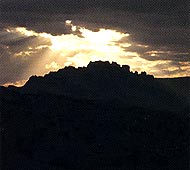




Paleontologists combine different lines of evidence to understand what it was like 150 million years ago. Each piece of information; from the types of rocks; to plant fossils; to remains of the frogs; lizards; and salamanders living at the same time as the dinosaurs; helps scientists describe what northeastern Utah looked like when the dinosaurs roamed.
Scientists now believe that the dinosaurs found in the Douglass Quarry lived in a broad, semi-arid to arid, interior lowland plain. The inland plain extended from New Mexico and Arizona northward to Montana and into Alberta and British Columbia, Canada. A volcanic mountain chain, similar to the present-day Andes, existed about where California borders Nevada and Arizona. Additional mountains existed near where Nevada borders Utah today. These highlands acted as a barrier for the westerly to southwesterly winds. The inland plain was in a rain shadow that made for the mostly dry climate.

 |
||||
A large stream complex running from the western highlands to the eastern plain, gave way to a large shallow saline, alkaline lake at the time Douglass Quarry dinosaurs were living in the inland plain. It covered parts of northwestern New Mexico, northeastern Arizona, southeastern Utah, and southwestern Colorado. The lake was similar in size to Lake Michigan. At times, the alkalinity probably would have been high enough to cause burns to human skin [had there been any humans around to test it.] There were also fresher water lakes to the east and north of the present-day Rocky Mountain Front Range.
Despite the dry climate, life-giving water was delivered to the inland plain in a variety of ways. These included seasonal or intermittent precipitation, perennial and intermittent streams that drained the western highlands, and shallow groundwater that was delivered by aquifers recharged by infiltration in the western highlands.
Riparian vegetation was largely supported by water from perennial streams. Vegetation located throughout the rest of the inland plain depended primarily on direct precipitation that may have been largely seasonal, or the ability to use shallow aquifers. The large plant-eating sauropods could range across the inland plain in search of water and food. Smaller animals would have found water and shelter in the riparian habitats along waterways. Aquatic life was present in the scattered lakes and ponds.
The semi-arid interior plain supported a relatively diverse ecosystem. This included the dinosaurs whose bodies would later form part of the logjam of bones that is now the Douglass Quarry.


















